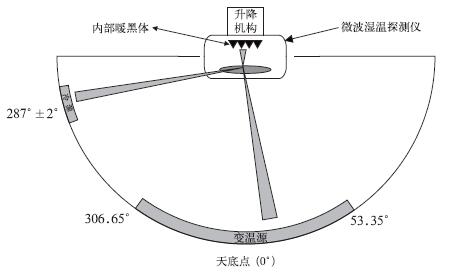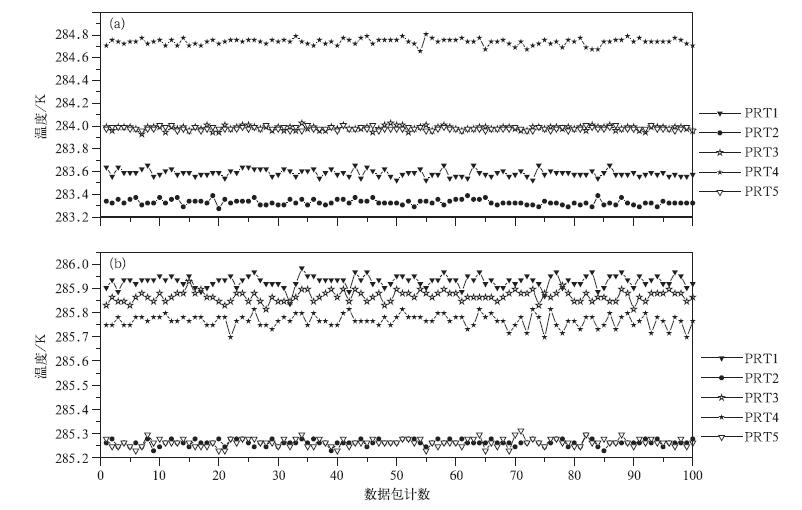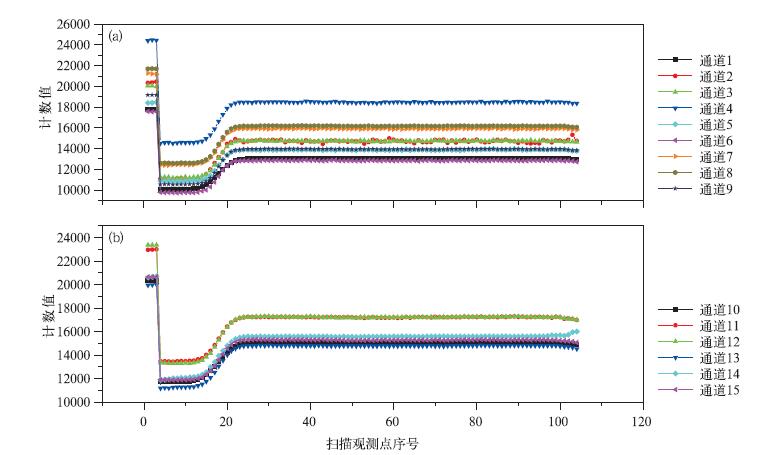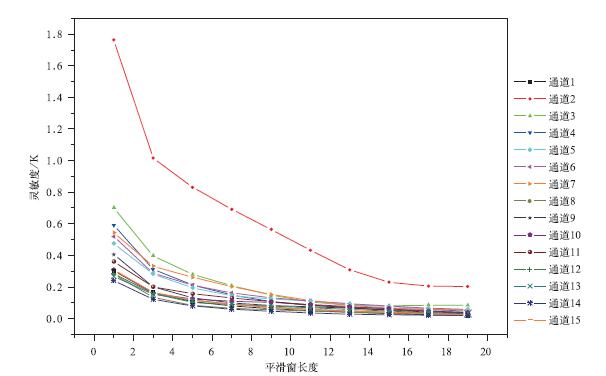Radiometric Characteristics of FY-3C Microwave Humidity and Temperature Sounder
-
摘要: 2013年9月发射的FY-3C是我国第2代极轨气象卫星的第3颗星,其上装载的微波湿温探测仪在118 GHz氧气吸收线和183 GHz水汽吸收线设计了两组大气探测通道,在大气窗区设置了89 GHz和150 GHz探测通道。为保证微波湿温探测仪在轨定量应用,卫星发射前完成了地面热真空试验。该文介绍了热真空定标试验原理,并对FY-3C微波湿温探测仪正样产品真空试验数据进行了定量分析。数据分析结果表明:FY-3C微波湿温探测仪正样产品15个探测通道的灵敏度均满足设计指标要求,各通道观测亮温间相对独立,定标准确度优于1.6 K,真空试验过程中微波湿温探测仪定标结果稳定。FY-3C微波湿温探测仪发射前热真空定标特性分析结果为仪器在轨定量应用奠定了基础。Abstract:
The microwave humidity sounder (MWHS) is a five channel microwave radiometer in the range of 150-191 GHz onboard FY-3A and FY-3B. FY-3A and FY-3B are successfully launched in 2008 and 2010, respectively. The next generation of MWHS is a microwave humidity and temperature sounder. This sensor is developed to fly on the third satellite of new generation polar orbit meteorological satellite of China (FY-3C) is launched in September 2013.The microwave humidity and temperature sounder has 15 channels in the range of 89-191 GHz. Eight temperature sounding channels with central frequency of 118.75 GHz oxygen gas line and five humidity sounding channels with central frequency of 183.31 GHz water vapor line. Two window channels center at 89 GHz and 150 GHz. 118 GHz channel is first used to detect atmosphere on current operational satellite. Channels in the oxygen band are at around 54 GHz used by AMSU-A (advanced microwave sounding unit-A) and ATMS (advanced technology microwave sounder). Channels in the next oxygen absorption band are at around 118.75 GHz, which can well detect atmosphere temperature in the lower troposphere. The temperature sounding channels around 118.75 GHz detect the atmosphere temperature from 900 hPa to 25 hPa. The microwave humidity and temperature sounder adds two humidity sounding channels compared with MWHS that can obtain fine vertical distribution structure of atmosphere humidity.In order to determine the radiometric performance and the on-orbit use of the microwave humidity and temperature sounder, an extensive test is performed before launch. The microwave humidity and temperature sounder is placed in a thermal-vacuum chamber where the cold and earth targets are installed at fixed position. The instrument temperature is controlled at 5℃, 15℃ and 25℃ which is expected in orbit. The temperature of earth target maintains from 95 K to 330 K and space target is controlled at 95 K. Temperatures of these whole targets are measured by PRT (platinum resistance thermometer) and the temperature measurement accuracy is better than 0.1 K. The test database include counts of internal blackbody, earth and cold targets are obtained by the new microwave radiometer and the temperature measured by PRT.The sounder is calibrated with the thermal-vacuum chamber test method, and test data are quantitatively analyzed. Results for noise equivalent differential temperatures of fifteen channels show that all fifteen channel measured sensitivities meet requirements of indicators. Noise equivalent differential temperatures of humidity channels are all below 0.5 K which are also at the same level of indicators from ATMS. The channels around 118.75 GHz except channel 2 are all below 1 K, and that means observations from these channels used for temperature retrieval are well. Because the narrow bandwidth of channel 2, the noise equivalent differential temperature of this channel is about 1.7 K that maybe affects retrieval precision. Correlations between all channels are independent. After correcting all biases, the calibration accuracy is well below 1.12 K. Calibration results of microwave humidity and temperature sounder are stability for each channel. The radiometric characteristic analysis of all channels provide useful reference for in-orbit application of the new microwave radiometer sounder on FY-3C.
-
表 1 微波湿温探测仪主要应用目的和通道特性参数①
Table 1 The microwave humidity and temperature sounder channel characteristics
序号 中心频率/GHz 极化 带宽/MHz 主波束宽度 主波束效率 1 89 V 1500 2.0° >92% 2 118.75±0.08 H 20 2.0° >92% 3 118.75±0.2 H 100 2.0° >92% 4 118.75±0.3 H 165 2.0° >92% 5 118.75±0.8 H 200 2.0° >92% 6 118.75±1.1 H 200 2.0° >92% 7 118.75±2.5 H 200 2.0° >92% 8 118.75±3.0 H 1000 2.0° >92% 9 118.75±5.0 H 2000 2.0° >92% 10 150 V 1500 1.1° >95% 11 183.31±1.0 H 500 1.1° >95% 12 183.31±1.8 H 700 1.1° >95% 13 183.31±3.0 H 1000 1.1° >95% 14 183.31±4.5 H 2000 1.1° >95% 15 183.31±7.0 H 2000 1.1° >95% 表 2 非线性订正后微波湿温探测仪各通道最大亮温偏差
Table 2 Max bias of brightness temperature after nonlinear correction
通道号 各仪器温度下的最大亮温偏差/K 5℃ 15℃ 25℃ 1 0.33 0.23 0.20 2 0.40 0.50 0.24 3 0.14 0.13 0.10 4 0.17 0.23 0.15 5 0.20 0.09 0.16 6 0.14 0.17 0.16 7 0.16 0.19 0.13 8 0.18 0.23 0.13 9 0.15 0.16 0.15 10 0.17 0.24 0.17 11 0.14 0.25 0.08 12 0.14 0.13 0.12 13 0.17 0.27 0.19 14 0.19 0.29 0.35 15 0.28 0.19 0.15 表 3 微波湿温探测仪各通道灵敏度
Table 3 Radiometric sensitivity values for the microwave humidity and temperature sounder
通道号 灵敏度指标/K 各仪器温度下的灵敏度/K 5℃ 15℃ 25℃ 1 1.0 0.226 0.301 0.257 2 3.6 1.790 1.763 1.663 3 2.0 0.679 0.701 0.686 4 1.6 0.548 0.591 0.568 5 1.6 0.635 0.475 0.485 6 1.6 0.535 0.519 0.470 7 1.6 0.538 0.544 0.511 8 1.0 0.310 0.281 0.306 9 1.0 0.421 0.405 0.304 10 1.0 0.296 0.307 0.289 11 1.0 0.456 0.360 0.393 12 1.0 0.371 0.284 0.350 13 1.0 0.231 0.266 0.250 14 1.0 0.287 0.240 0.266 15 1.0 0.282 0.309 0.249 表 4 微波湿温探测仪各通道观测亮温的相关系数
Table 4 Correlation maxrtix for the microwave humidity and temperature sounder
通道号 1 2 3 4 5 6 7 8 9 10 11 12 13 14 15 1 1 0.091 0.050 0.005 -0.089 0.049 -0.103 -0.043 -0.009 0.101 0.116 0.040 -0.042 -0.135 -0.016 2 0.091 1 -0.083 0.001 0.036 -0.016 0.085 -0.190 -0.015 -0.024 0.105 -0.001 0.039 -0.029 -0.004 3 0.050 -0.083 1 0.160 0.019 -0.042 0.133 0.073 0.114 0.065 -0.060 0.013 -0.086 -0.121 -0.079 4 0.005 0.001 0.160 1 0.015 0.074 0.036 0.082 0 0.016 0.041 -0.158 -0.003 0 -0.034 5 -0.089 0.036 0.019 0.015 1 0.059 0.037 0.012 0.051 0.024 -0.033 -0.042 0.023 -0.054 -0.106 6 0.049 -0.016 -0.042 0.074 0.059 1 0.011 0.104 0.078 -0.109 -0.087 -0.100 -0.033 -0.033 -0.099 7 -0.103 0.085 0.133 0.036 0.037 0.011 1 0.343 0.190 -0.144 -0.031 -0.042 -0.055 -0.008 0.025 8 -0.043 -0.190 0.073 0.082 0.012 0.104 0.343 1 0.554 -0.083 -0.059 -0.077 -0.149 0.031 -0.021 9 -0.009 -0.015 0.114 0 0.051 0.078 0.190 0.554 1 -0.020 -0.049 0.109 -0.052 0.068 0.037 10 0.101 -0.024 0.065 0.016 0.024 -0.109 -0.144 -0.083 -0.020 1 0.098 0.123 0.072 0.111 0.028 11 0.116 0.105 -0.060 0.041 -0.033 -0.087 -0.031 -0.059 -0.049 0.098 1 0.149 0.200 0.088 0.075 12 0.040 -0.001 0.013 -0.158 -0.042 -0.100 -0.042 -0.077 0.109 0.123 0.149 1 0.302 0.073 0.184 13 -0.042 0.039 -0.086 -0.003 0.023 -0.033 -0.055 -0.149 -0.052 0.072 0.200 0.302 1 0.244 0.274 14 -0.135 -0.029 -0.121 0 -0.054 -0.033 -0.008 0.031 0.068 0.111 0.088 0.073 0.244 1 0.254 15 -0.016 -0.004 -0.079 -0.034 -0.106 -0.099 0.025 -0.021 0.037 0.028 0.075 0.184 0.274 0.254 1 -
[1] Dong C, Yang J, Zhang W, et al.An overview of a new Chinese weather satellite FY-3A.Bull Amer Meteor Soc, 2009, 90:1531-1544. doi: 10.1175/2009BAMS2798.1 [2] 董立新, 杨虎, 张鹏, 等.FY-3A陆表温度反演及高温天气过程动态监测.应用气象学报, 2012, 23(2):214-222. doi: 10.11898/1001-7313.20120210 [3] 胡秀清, 黄意玢, 陆其峰, 等.利用FY-3A近红外资料反演水汽总量.应用气象学报, 2011, 22(1):46-56. doi: 10.11898/1001-7313.20110105 [4] 漆成莉, 董超华, 张文建, 等.FY-3A气象卫星红外分光计温度廓线模拟反演试验.应用气象学报, 2005, 16(5):576-582. doi: 10.11898/1001-7313.20050503 [5] 陆其峰.风云三号A星大气探测资料数据在欧洲中期天气预报中心的初步评价与同化研究.中国科学:地球科学, 2011, 41(7):890-894. http://www.cnki.com.cn/Article/CJFDTOTAL-JDXK201107004.htm [6] 何杰颖, 张升伟.FY-3A星MWHS反演中纬度和热带大气水汽.遥感学报, 2012, 16(3):562-578. doi: 10.11834/jrs.20120286 [7] 杜明斌, 杨引明, 杨玉华, 等.FY-3A微波资料偏差订正及台风路径预报应用.应用气象学报, 2012, 23(1):89-95. http://qikan.camscma.cn/jams/ch/reader/view_abstract.aspx?file_no=20120110&flag=1 [8] 崔林丽, 杨引明, 游然, 等.FY-3A/MWHS数据在定量降水估计中的应用研究.高原气象, 2012, 31(5):1439-1445. http://www.cnki.com.cn/Article/CJFDTOTAL-GYQX201205028.htm [9] 杨引明, 杜明斌, 张洁.FY-3A微波资料在"莫拉克"台风预报中的同化试验.热带气象学报, 2012, 28(1):23-30. http://www.cnki.com.cn/Article/CJFDTOTAL-RDQX201201003.htm [10] 任强, 董佩明, 薛纪善.台风数值预报中受云影响微波卫星资料的同化试验.应用气象学报, 2009, 20(2):137-146. doi: 10.11898/1001-7313.20090202 [11] Weng F, Zou X, Yan B, et al.Applications of special sensor microwave imager and sounder (SSMIS) measurements in weather and climate studies.Adv Met S&T, 2012, 1(1):14-24. [12] Prigent C, Chevallier F, Karbou F, et al.AMSU-A land surface emissivity estimation for numerical weather prediction assimilation schemes.J Appl Meteor, 2005, 44(4):416-426. doi: 10.1175/JAM2218.1 [13] Zhao Y, Wang B, Ji Z, et al.Improved track forecasting of a typhoon reaching landfall from four-dimensional variational data assimilation of AMSU-A retrieved data.J Geophys Res, 2005, 110(D14):D14101. http://adsabs.harvard.edu/abs/2005JGRD..11014101Z [14] Karbou F, Gérard E, Rabier F.Global 4DVAR assimilation and forecast experiments using AMSU observations over land.Part I:Impacts of various land surface emissivity parameterizations.Wea Forecasting, 2010, 25(1):5-19. doi: 10.1175/2009WAF2222243.1 [15] JPL D-17005.Airs Project.Algorthm Theoretical Basis Document.Level 1b, Part 3:Microwave Instruments.Version 2.1.2000. [16] Saunders R W, Hewison T J, Stringer S J, et al.The radiometric characterization of AMSU-B.IEEE Transactions on Microwave Theory and Techniques, 1995, 43(4):760-771. doi: 10.1109/22.375222 [17] NPP ATMS Science Team.NPOESS Preparatory Project Advanced Technology Microwave Sounder (ATMS) Postlaunch Calibration and Validation Plan.Pubilicly Accessible Version, 2007. [18] 谷松岩, 王振占, 李靖, 等.风云三号A星微波湿度计主探测通道辐射特性.应用气象学报, 2010, 21(3):335-342. doi: 10.11898/1001-7313.20100309 [19] Gu S, Guo Y, Wang Z, et al.Calibration analyses for sounding channels of MWHS onboard FY-3A.IEEE Transactions on Geoscience and Remote Sensing, 2012, 50(12):4885-4891. doi: 10.1109/TGRS.2012.2214391 [20] Wang Z, Li J, Zhang S, et al.Prelaunch Calibration of Microwave Humidity Sounder on China's FY-3A Meteorological Satellite.Geoscience and Remote Sensing Letters, IEEE, 2011, 8(1):29-33. doi: 10.1109/LGRS.2010.2050676 [21] 吴雪宝, 漆成莉, 刘辉.风云三号卫星地面应用系统工程研发项目技术报告.北京:国家卫星气象中心, 2007. http://www.cnki.com.cn/Article/CJFDTOTAL-SYQY201603027.htm [22] Rodgers C D.Retrieval of atmospheric temperature and composition from remote measurements of thermal radiation.Reviews of Geophysics, 1976, 14(4):609-624. doi: 10.1029/RG014i004p00609 -


 设为首页
设为首页 加入收藏
加入收藏



 下载:
下载:




